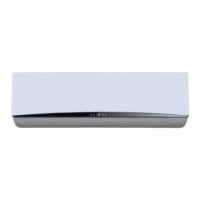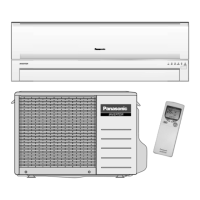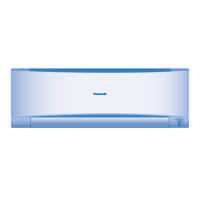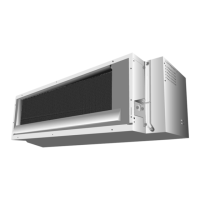Do you have a question about the Panasonic CU-UE12JKE and is the answer not in the manual?
Explains symbols used for safety instructions to indicate prohibited or compulsory actions.
Precautions for using the remote control and batteries, including handling and storage.
Important safety rules for the indoor unit installation, operation, and maintenance.
Guidelines for safe electrical connections, usage, and grounding.
Safety measures related to the outdoor unit, including handling and installation.
Information on intended use, supervision, and general precautions for appliance users.
Specifies temperature ranges for cooling and heating operation for optimal performance.
Details on wiring colors and proper disposal of old equipment and batteries according to directives.
Identifies key parts of the indoor and outdoor units, including air filters and louvers.
Explains the Auto OFF/ON button and the remote control display indicators.
Instructions on turning the unit on/off and setting the desired temperature.
Guides on choosing AUTO, HEAT, DRY, or COOL modes for desired comfort.
Explains fan speed settings and vertical airflow direction control.
Details on POWERFUL/QUIET modes and optional settings for power saving.
Instructions for setting, confirming, and cancelling various timer operations.
Safety advice, including unplugging the unit, before performing any cleaning.
Details on washing the unit, air filters, and front panel using appropriate methods.
Guidelines for seasonal inspection and preparation for extended non-use.
Criteria for when to call for professional service, indicating issues beyond user repair.
Describes phenomena like mist or water flow that are not malfunctions.
Actions to take, such as checking settings and obstructions, before calling a technician.
Procedure to retrieve error codes using the remote control for diagnosis.
Details on model, power, refrigerant, capacity, noise levels, and dimensions.
Information on the conditions (temperature, humidity) under which specifications were tested.
Explains symbols used for safety instructions to indicate prohibited or compulsory actions.
Precautions for using the remote control and batteries, including handling and storage.
Important safety rules for the indoor unit installation, operation, and maintenance.
Guidelines for safe electrical connections, usage, and grounding.
Safety measures related to the outdoor unit, including handling and installation.
Information on intended use, supervision, and general precautions for appliance users.
Specifies temperature ranges for cooling and heating operation for optimal performance.
Details on wiring colors and proper disposal of old equipment and batteries according to directives.
Identifies key parts of the indoor and outdoor units, including air filters and louvers.
Explains the Auto OFF/ON button and the remote control display indicators.
Instructions on turning the unit on/off and setting the desired temperature.
Guides on choosing AUTO, HEAT, DRY, or COOL modes for desired comfort.
Explains fan speed settings and vertical airflow direction control.
Details on POWERFUL/QUIET modes and optional settings for power saving.
Instructions for setting, confirming, and cancelling various timer operations.
Safety advice, including unplugging the unit, before performing any cleaning.
Details on washing the unit, air filters, and front panel using appropriate methods.
Guidelines for seasonal inspection and preparation for extended non-use.
Criteria for when to call for professional service, indicating issues beyond user repair.
Describes phenomena like mist or water flow that are not malfunctions.
Actions to take, such as checking settings and obstructions, before calling a technician.
Procedure to retrieve error codes using the remote control for diagnosis.
Details on model, power, refrigerant, capacity, noise levels, and dimensions.
Information on the conditions (temperature, humidity) under which specifications were tested.
| Outdoor unit weight | 30000 g |
|---|---|
| Outdoor units quantity | 1 |
| Outdoor unit noise level | 63 dB |
| Outdoor unit dimensions (WxDxH) | 780 x 289 x 540 mm |
| Type | Air conditioner outdoor unit |
| Compressor type | Rotary |
| Built-in display | No |
| Hose length (max) | 15 m |
| Refrigerating medium | R410A |
| Cooling capacity (max) | 11940 BTU/h |
| Dehumidifying capacity | 2 l/h |
| Heating capacity (max) | 14490 BTU/h |
| Air conditioner functions | cooling, heating |
| Cooling capacity in watts (max) | 3500 W |
| Heating capacity in watts (max) | 4250 W |
| Cooling energy efficiency (EER, W/W) | 3.3 |
| Heating energy efficiency (COP, W/W) | 3.63 |
| Indoor units quantity | 0 |
| Noise level (high speed) | 50 dB |
| Power consumption (typical) | 900 W |












